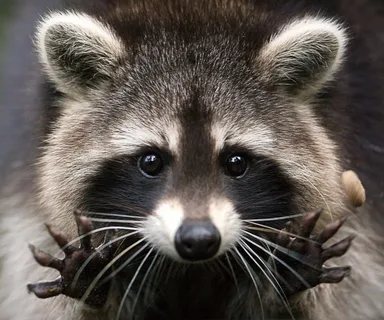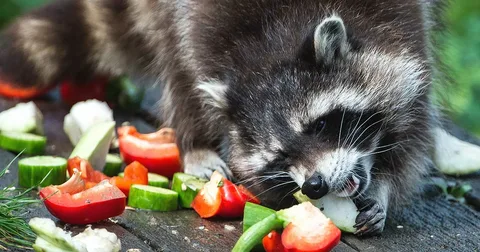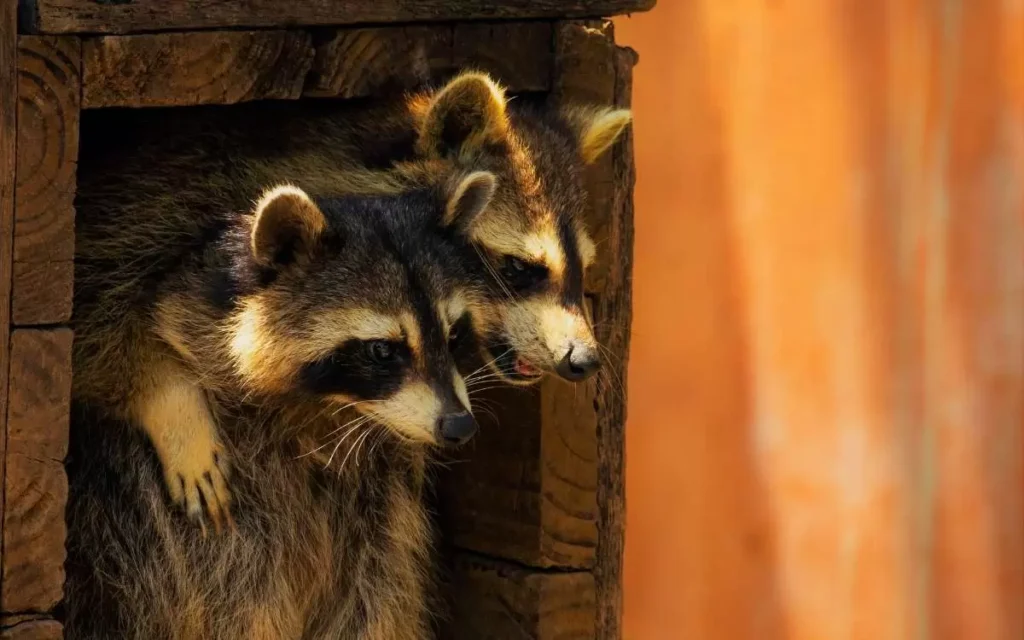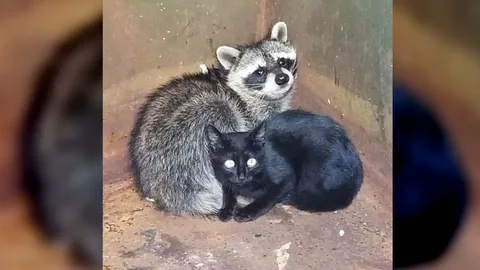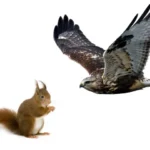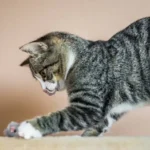As wildlife inhabiting suburban and urban green spaces continue interacting with domestic pets, old myths persist warning of potential dangers. Raccoons in particular garner suspicions of lurking as cat snatching predators. But does reality align with reputation?
Let’s investigate raccoon natural behaviors, thoroughly review studies and reports on raccoon feline relationships, and gain a balanced understanding serving our furry companions and backyard wildlife alike.
Raccoons: Opportunistic Omnivores, not Predators
While popular culture depicts raccoons as scrappy mini bears battling anything for a meal, their anatomy and diet tell another story. With fox like faces and ringed tails, raccoons are actually aquatic procyonids more closely related to coatis than ursine. Specialized hands with opposable “thumbs” grant deft problem solving but lack bear like strength.
As omnivores, raccoons embrace an array of foods procured with cerebral versus combative strategies. Through various habitats and seasons, their menus incorporate:
| Food Type | Examples | Seasonal Frequency |
| Invertebrates |
Insects, crustaceans, mollusks, worms |
Year round stable supply |
| Vertebrates |
Amphibians, fish, small mammals |
Opportunistic opportunities |
| Plants |
Fruits, nuts, grains, tubers |
Peak seasonal abundances |
|
Other |
Eggs, garbage, pet food |
Scavenged supplements |
While willing opportunists, raccoons feed primarily on bountiful invertebrates, plants and human offerings requiring minimal effort. Rarely do studies confirm focused predation on sizable vertebrates necessitating complex hunting. As nature’s problem-solvers adapting alongside humanity, convenience drives raccoon diets more than caloric needs.
Raccoon Social Structures and Territorial Patterns
In contrast to dogged pack stereotypes, raccoons lead predominantly solitary lives. Females remain together briefly to mate and independently raise one litter annually lasting spring through summer. Out of birthing seasons, distances between raccoons expand as they forage alone across 1-5 square miles.
How does this lifestyle impact potential interactions? Between widely spaced individuals preferring parallel paths, direct conflicts are uncommon. Only during birthing seasons do raccoons aggressively defend concentrated territorial radii encompassing dens, tolerating no intrusions including conspecifics.
Otherwise, occasional territoriality appears during mating periods or versus other competitors at nourishing hotspots who threaten current feeding. Bluff charges typically resolve disputes without wounds through assertive communication. Conflict avoidance prevails through brief sparring or temporary sharing until resources replenish.
Understanding Natural Interactions
Given evolved separation, average encounters between nocturnal raccoons and housecats resting inside are few. But what realities emerge from areas where their paths intersect? Studies cite three scenarios requiring closer scrutiny:
- Sick/Injured Cats – In extremely rare situations, incapacitated outdoor cats were killed, most likely seen as vulnerable prey by opportunistic raccoons.
- Mother Raccoons – Highly protective when raising kits, provoked mothers may rarely swat stray cats venturing too near concealed daytime dens out of provocation, not predation.
- Feral Cat Colonies – While claiming meals abandoned by people, raccoons facing feral colonies may defend territories through infrequent hunting of weaker members as direct competitors.
However, even these outliers involve heightened circumstances arousing protective or opportunistic raccoon instincts near enclosed shelters, not routine preying. Where overlap occurs naturally without aggravating factors, observational data and anecdotal reports consistently highlight:
- Indifference as Primary Response
- Brief Chase Scene Defusing Quickly
- Rare Low-intensity Spats without Injury
- Shared Foraging with Parallel Paths
- Occasional Grooming Symbiosis
Overall, studies conclude raccoons and housecats maintain an “avoid and ignore” stance towards each other except under unusual conditions bringing protective instincts into conflict near concentrated resources and enclosed spaces. Their innate behaviors co-exist cooperatively where context allows separation in shared greenspaces.
Promoting Understanding in Suburban Settings
Sensitivity towards natural wildlife rhythms encourages sustainable co-habitation. Minor adjustments allowing wildlife flows unimpeded while protecting pets foster mutual understanding:
- Manage edible landscaping deliberately, discouraging windfalls and smorgasbords attracting multitudes.
- Store pet foods indoors or in raccoon-proof containers preventing enticements near houses.
- Position water sources 20+ feet away for cats yet not trapping wildlife reliant on natural flows.
- Contact authorized wildlife operators solely as last resort if unresolved property damage occurs.
- Determine vaccination protocols for outdoor cats considering zoonotic disease risks in areas.
- Identify pets visibly in case minor disputes require medical attention as rare exceptions.
- Remove attractants empowering raccoons habituated adjusting behaviors around homes seeking food.
With conscientious care for all inhabitants, balance honors benefits raccoons and housecats provide while curtailing perceived threats through reality based solutions.
Together they peacefully shared suburbs for generations until myths grew too resilient without facts. Understanding dispels legends allowing compassion for neighbors, great and small, dwelling in shrinking green corridors.
Additional Considerations for Thoughtful Coexistence
Further awareness cultivates appreciation between fence line neighbors:
- Monitor kittens/elderly cats near birthing season dens given heightened defensiveness.
- Provide alternative water access away from houses or risk concentration of critters.
- Report concerning daylight raccoon behavior/appearance to authorities.
- Consider Native Plantings attracting wildlife naturally, undisturbed by pets.
- Participate in local wildlife education amplifying respect through facts over fallacy.
- Celebrate raccoons’ roles as nature’s problem-solvers fulfilling ecological services quietly alongside companionship.
With wisdom acknowledging shared spaces, sensitive stewardship balances interests sustainably. Alertness and preparedness curb unrealistic worries while compassion guides multi species neighborhoods where all find refuge.
Through understanding, myths dividing wildlife from wellbeing dissolve into peaceful acquaintances appreciated within natural rhythms.
FREQUENTLY ASK QUESTIONS:
Q: Are raccoons a danger to cats?
A: Raccoons have been known to kill small dogs and cats
Q: Can a cat fight off a raccoon?
A: a raccoon is almost likely always going to beat a cat in a full-blown fight,
Q: What predators eat cats?
A: coyotes, eagles, owls, raccoons, dogs and otters
Q: Do raccoons eat other animals?
A: they will eat both plants and other animals.
CONCLUSION
while rare incidents between raccoons and cats can occur, the overall data shows raccoons do not typically classify domestic cats as prey. Their natural diets and social behaviors, as opportunistic omnivores and largely solitary animals, do not include active predation of sizable animals as a major food source.
With larger prey like cats, raccoons typically avoid confrontation and will only engage under highly unusual situational factors like confinement or an injured/sickly animal. By taking reasonable preventative measures and understanding raccoon ecology, cat owners need not fear raccoons as a serious threat to beloved feline family members in suburban environments where both species peacefully coexist.

Hello! I am Methew Hills and I am from USA. I am a professional SEO content writer since 2018 and i am also a Teacher.
